标签:style blog http color java os io strong
声明:本文是对某高中生的竞赛论文学习的文章
介绍:
二叉查找树能够支持多种动态集合操作。对于一个含有n个结点的完全二叉树,这些操作的最还情况运行时间是O(lgn),但如果树是含有n个结点的线性链,则这些操作的最坏情况运行时间为O(n)。而像红黑树、AVL树这种二叉查找树的变形在最坏情况下,仍能保持较好性能。
本文将要介绍的伸展树也是二叉查找树的变形,它对空间要求及编程难度的要求相对不高。
伸展树:
伸展树与二叉查找树一样,具有有序性。即伸展树的每一个结点x满足:该结点的左子树中的每个元素都小于x,而其右子树的每一个元素都大于x。与二叉查找树不同的是,伸展树可以自我调整,也就是伸展操作(Splay)。
伸展操作Splay(x,S)
伸展操作是在保持伸展树有序的前提下,通过一系列旋转将伸展树T中的元素x调整至树的根部。在调整的过程中,分以下三种情况处理:
1、结点x的父节点y是根节点。
这时,如果x是y的左孩子,我们进行一次Zig(右旋)操作;
如果x是y的右孩子,我们进行一次Zag(左旋)操作;
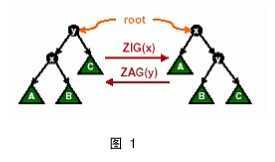
2、结点x的父节点y不是根节点,y的父节点为z。
且x与y同时是各自父节点的左孩子,这时我们进行Zig-Zig操作;
或者是同时是各自父节点的右孩子,这时我们进行一次Zag-Zag操作。
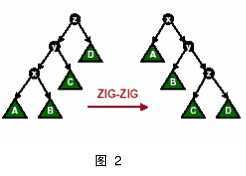
3、结点x的父节点y不是根节点,y的父节点为z。
且x与y分别是其父节点的左孩子和右孩子,这时我们进行一次Zig-Zag操作。
或者是x与y分别是其父节点的右孩子和左孩子,这时我们进行一次Zag-Zig操作。
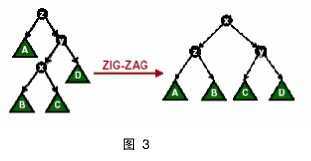
如下图所示,执行Splay(1,T),将元素1调整的树根的位置,执行Splay(2)将元素2调整到树根的位置。从直观上看,树比原来“平衡”多了,而伸展操作的过 程并不复杂,只需要左旋和右旋。
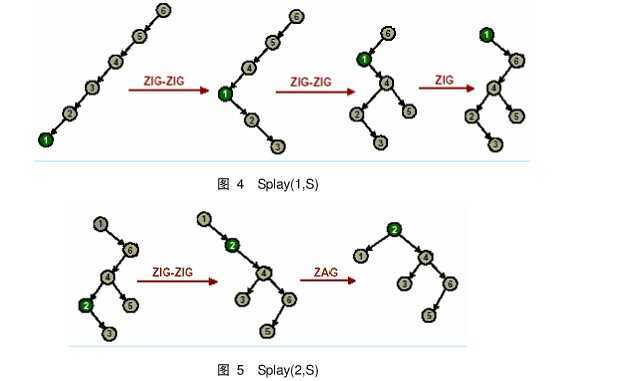
基本操作:
利用Splay可以在伸展树上T上作如下操作,
查找:判断元素x是否在伸展树T表示的有序集中;
跟二叉查找树的查找操作一样,在伸展树中查找x,如果x在伸展树中,则再执行Splay(x,T)调整伸展树。
插入:将元素x插入到伸展树T表示的有序集中;
跟二叉查找树的插入操作一样,将元素x插入到伸展树的相应位置,在执行Splay(x,T)调整伸展树。
删除:将元素x从伸展树T表示的有序集中删除;
首先,查找的元素x所在的位置,如果x没有孩子或者只有一个孩子,直接删除掉x,再对x的父节点执行Splay,将x的父节点调整到根位置。否 则,查找x的后继y,用y代替x的位置,然后执行Splay(y,T),将y调整到根节点位子。
合并:将两个伸展树T1、T2合并成一个伸展树。其中S1中的所有元素都小于T2中的元素。
首先,找到T1中最大的元素x,在执行Splay(x,T1)将x调整到T1的根位置,然后将T2作为x的右子树就得到新的伸展树T。
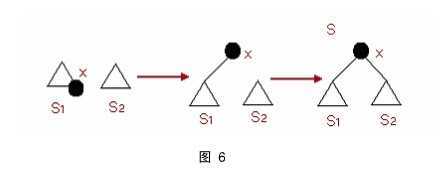
划分:以元素x为边界,将伸展树T划分成两个伸展树T1和T2,其中,T1中的元素都小于x,T2中的元素都大于x。
首先,执行查找操作,将元素x调整为根位置,x的左子树为T1,右子树为T2。
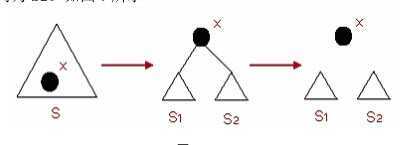
除了上述操作外,伸展树还可以有其他的操作。
时间复杂度:
所有的操作其平摊复杂度为O(lgn)。
程序实现:
1 package datastructure; 4 import java.util.List; 5 import java.util.ArrayList; 6 10 public class SplayTree { 11 class TreeNode{ 12 private int key; 13 private String data; 14 private TreeNode left; 15 private TreeNode right; 16 private TreeNode parent; 17 18 public TreeNode(int key,String data,TreeNode left,TreeNode right,TreeNode parent) { 19 this.key = key; 20 this.data = data; 21 this.left = left; 22 this.right = right; 23 this.parent = parent; 24 } 25 public int getKey() { 26 return key; 27 } 28 public String toString(){ 29 String leftKey = (left == null ? " " : String.valueOf(left.key)); 30 String rightKey = (right == null ? " " : String.valueOf(right.key)); 31 return "(" + leftKey +"," + key + "," + rightKey + ")"; 32 } 33 } 34 private TreeNode root = null; 35 public boolean IsEmpty() 36 { 37 if(root == null) 38 { 39 return true; 40 } 41 else 42 { 43 return false; 44 } 45 } 46 public TreeNode Insert(int key) { 47 TreeNode parentNode = null; 48 TreeNode newNode = new TreeNode(key, "v", null, null, null); 49 TreeNode pNode = root; 50 if(pNode == null) 51 { 52 root = newNode; 53 return root ; 54 } 55 while(pNode != null) 56 { 57 parentNode = pNode; 58 if(key < pNode.key) 59 { 60 pNode = pNode.left; 61 } 62 else if(key > pNode.key) 63 { 64 pNode = pNode.right; 65 } 66 else 67 { 68 return pNode;//树中已存在与新结点的关键字相同的结点 69 } 70 } 71 newNode.parent = parentNode; 72 if(newNode.key < parentNode.key) 73 { 74 parentNode.left = newNode; 75 return parentNode.left; 76 } 77 else 78 { 79 parentNode.right = newNode; 80 return parentNode.right; 81 } 82 83 84 } 85 private List<TreeNode> nodeList = new ArrayList<TreeNode>(); 86 87 public List<TreeNode> getNodeList() { 88 return nodeList; 89 } 90 91 //获取中序列表 92 public List<TreeNode> Inorder_SplayTree_WalkList() 93 { 94 if(nodeList != null) 95 { 96 nodeList.clear(); 97 } 98 Inorder_SplayTree_Walk(root); 99 return nodeList; 100 } 101 //中序遍历树 102 private void Inorder_SplayTree_Walk(TreeNode root) 103 { 104 if(root != null) 105 { 106 Inorder_SplayTree_Walk(root.left); 107 nodeList.add(root); 108 Inorder_SplayTree_Walk(root.right); 109 } 110 } 111 //给定关键字key,查找到该结点 112 private TreeNode Search(int key) 113 { 114 TreeNode pNode = root; 115 while(pNode != null && pNode.key != key) 116 { 117 if(key<pNode.key) 118 { 119 pNode = pNode.left; 120 } 121 else { 122 pNode = pNode.right; 123 } 124 } 125 return pNode; 126 } 127 //左旋转:x的右孩子y不空,以x与y之间的链为之架 128 private void leftRotate(TreeNode pNode) 129 { 130 TreeNode xNode = pNode; 131 TreeNode yNode = xNode.right; 132 xNode.right = yNode.left; 133 if(yNode.left != null) 134 { 135 yNode.left.parent = xNode; 136 } 137 yNode.parent = xNode.parent; 138 if(xNode.parent == null) 139 { 140 root = yNode; 141 } 142 else if(xNode.parent.left == xNode) 143 { 144 xNode.parent.left = yNode; 145 }else { 146 xNode.parent.right = yNode; 147 } 148 yNode.left = xNode; 149 xNode.parent = yNode; 150 } 151 //右旋转:x的左孩子y不空,以x与y之间的链为支架右旋转 152 private void rightRotate(TreeNode pNode) 153 { 154 TreeNode xNode = pNode; 155 TreeNode yNode = xNode.left; 156 xNode.left = yNode.right; 157 if(yNode.right != null) 158 { 159 yNode.right.parent = xNode; 160 } 161 yNode.parent = xNode.parent; 162 if(xNode.parent == null) 163 { 164 root = yNode; 165 }else if(xNode.parent.left == xNode) 166 { 167 xNode.parent.left = yNode; 168 } 169 else { 170 xNode.parent.right = yNode; 171 } 172 yNode.right = xNode; 173 xNode.parent = yNode; 174 } 175 176 public void Splay(int key) 177 { 178 TreeNode xNode = Search(key); 179 if(xNode == null) 180 { 181 return; 182 } 183 SplayT(xNode,this.root); 184 } 185 186 //伸展树的Splay操作展操作是在保持伸展树有序的前提下, 187 //通过一系列旋转将伸展树T中的元素x调整至树的根部。 188 //在调整的过程中,分以下三种情况处理: 189 private void SplayT(TreeNode xNode,TreeNode Troot) 190 { 191 192 if(Troot == null || xNode == Troot) 193 { 194 return ; 195 } 196 while(xNode.parent != null) //x是否到达根位置 197 { 198 // 1、结点x的父节点y是根节点。 199 if(xNode.parent == Troot) 200 { 201 if (xNode.parent.left == xNode) 202 { 203 //如果x是y的左孩子,我们进行一次Zig(右旋)操作; 204 rightRotate(xNode.parent); 205 } 206 else 207 { 208 //如果x是y的右孩子,我们进行一次Zag(左旋)操作; 209 leftRotate(xNode.parent); 210 } 211 } 212 else 213 { 214 //2、结点x的父节点y不是根节点,y的父节点为z。 215 TreeNode yNode = xNode.parent; 216 if(yNode != null) 217 { 218 TreeNode zNode = yNode.parent; 219 if(xNode == yNode.left && yNode ==zNode.left) 220 { 221 //x与y同时是其父节点的左孩子 222 rightRotate(zNode); 223 rightRotate(yNode); 224 } 225 else if(xNode == yNode.right && yNode == zNode.right) 226 { 227 //x与y同时是其父节点的右孩子 228 leftRotate(zNode); 229 leftRotate(yNode); 230 }else if (xNode==yNode.left && yNode == zNode.right) 231 { 232 //x是其父节点的左孩子,y是父节点的右孩子 233 rightRotate(xNode.parent); 234 leftRotate(xNode.parent); 235 236 }else 237 { 238 //x是其父节点的右孩子,y是父节点的左孩子 239 leftRotate(xNode.parent); 240 rightRotate(xNode.parent); 241 } 242 } 243 } 244 245 } 246 } 247 //伸展树的查找操作 248 public void SplayTree_Search(int x,TreeNode Troot) 249 { 250 TreeNode xNode = Search(x); 251 if(xNode == null) 252 { 253 return; 254 } 255 SplayT(xNode, Troot); 256 } 257 //伸展树的插入操作 258 public void SplayTree_Insert(int x,TreeNode Troot) 259 { 260 TreeNode xNode = Insert(x); 261 if(xNode == null) 262 { 263 return; 264 } 265 SplayT(xNode, Troot); 266 } 267 //伸展树的删除操作 268 public void SplayTree_Delete(int x,TreeNode Troot) throws Exception 269 { 270 TreeNode xNode = Search(x); 271 if(xNode == null) 272 { 273 throw new Exception("树中不存在要删除的元素x"); 274 } 275 SplayTree_Remove(xNode,Troot); 276 } 277 private void SplayTree_Remove(TreeNode xNode,TreeNode Troot) throws Exception 278 { 279 280 if(xNode == null) 281 { 282 return; 283 } 284 TreeNode parentNode = xNode.parent; 285 if(xNode.left == null && xNode.right == null) 286 { 287 if(parentNode.left == xNode) 288 { 289 parentNode.left = null; 290 SplayT(parentNode, Troot); 291 } 292 if(parentNode.right == xNode) 293 { 294 parentNode.right = null; 295 SplayT(parentNode,Troot); 296 } 297 } 298 if(xNode.left != null && xNode.right == null) 299 { 300 if(parentNode.left == xNode) 301 { 302 xNode.left.parent = parentNode; 303 parentNode.left = xNode.left; 304 SplayT(parentNode, Troot); 305 } 306 if(parentNode.right == xNode) 307 { 308 xNode.left.parent = parentNode; 309 parentNode.right = xNode.left; 310 SplayT(parentNode,Troot); 311 } 312 } 313 if(xNode.left == null && xNode.right != null) 314 { 315 if(parentNode.left == xNode) 316 { 317 xNode.right.parent = parentNode; 318 parentNode.left = xNode.right; 319 SplayT(parentNode, Troot); 320 } 321 if(parentNode.right == xNode) 322 { 323 xNode.right.parent = parentNode; 324 parentNode.right = xNode.right; 325 SplayT(parentNode, Troot); 326 } 327 } 328 //x的左右儿子都不为空,就删除后继,让后继的内容,代替当前内容 329 TreeNode successorNode = SplayTree_Successor(xNode); 330 xNode.key = successorNode.key; 331 xNode.data = successorNode.data; 332 SplayTree_Remove(successorNode,Troot); 333 SplayT(successorNode, Troot); 334 } 335 public TreeNode SplayTree_Successor(TreeNode xNode) throws Exception 336 { 337 if(xNode == null) 338 { 339 return null; 340 } 341 TreeNode pNode = xNode; 342 //若右子树不空,则为右子树中最小的关键字 343 if(pNode.right != null) 344 { 345 return Tree_Minimum(pNode.right); 346 } 347 TreeNode parentNode = xNode.parent; 348 //若右子树为空,且x有一个后继y.则y是x的最低祖先结点,且y的左儿子也是x的祖先 349 while(parentNode != null && pNode == parentNode.right) 350 { 351 pNode = parentNode; 352 parentNode = pNode.parent; 353 } 354 return parentNode; 355 } 356 public TreeNode Tree_Maxmum(TreeNode Troot) throws Exception 357 { 358 if(Troot == null) 359 { 360 throw new Exception("树为空"); 361 } 362 TreeNode xNode = Troot; 363 while(xNode.right != null) 364 { 365 xNode = xNode.right; 366 } 367 return xNode; 368 } 369 public TreeNode Tree_Minimum(TreeNode Troot) throws Exception 370 { 371 if(Troot == null) 372 { 373 throw new Exception("树为空"); 374 } 375 TreeNode xNode = Troot; 376 while(xNode.left != null) 377 { 378 xNode = xNode.left; 379 } 380 return xNode; 381 } 382 public void SplayTree_Minimum(TreeNode Troot) throws Exception 383 { 384 TreeNode xNode = Tree_Minimum(Troot); 385 if(xNode == null) 386 { 387 return; 388 } 389 SplayT(xNode,Troot); 390 } 391 public TreeNode SplayTree_Join(TreeNode Troot1,TreeNode Troot2) throws Exception 392 { 393 TreeNode xNode = Tree_Maxmum(Troot1); 394 if(xNode == null) 395 { 396 return null; 397 } 398 SplayT(xNode, Troot1); 399 xNode.right = Troot2; 400 Troot2.parent = xNode; 401 return xNode; 402 403 } 404 405 }
标签:style blog http color java os io strong
原文地址:http://www.cnblogs.com/Jiaoxia/p/3895211.html